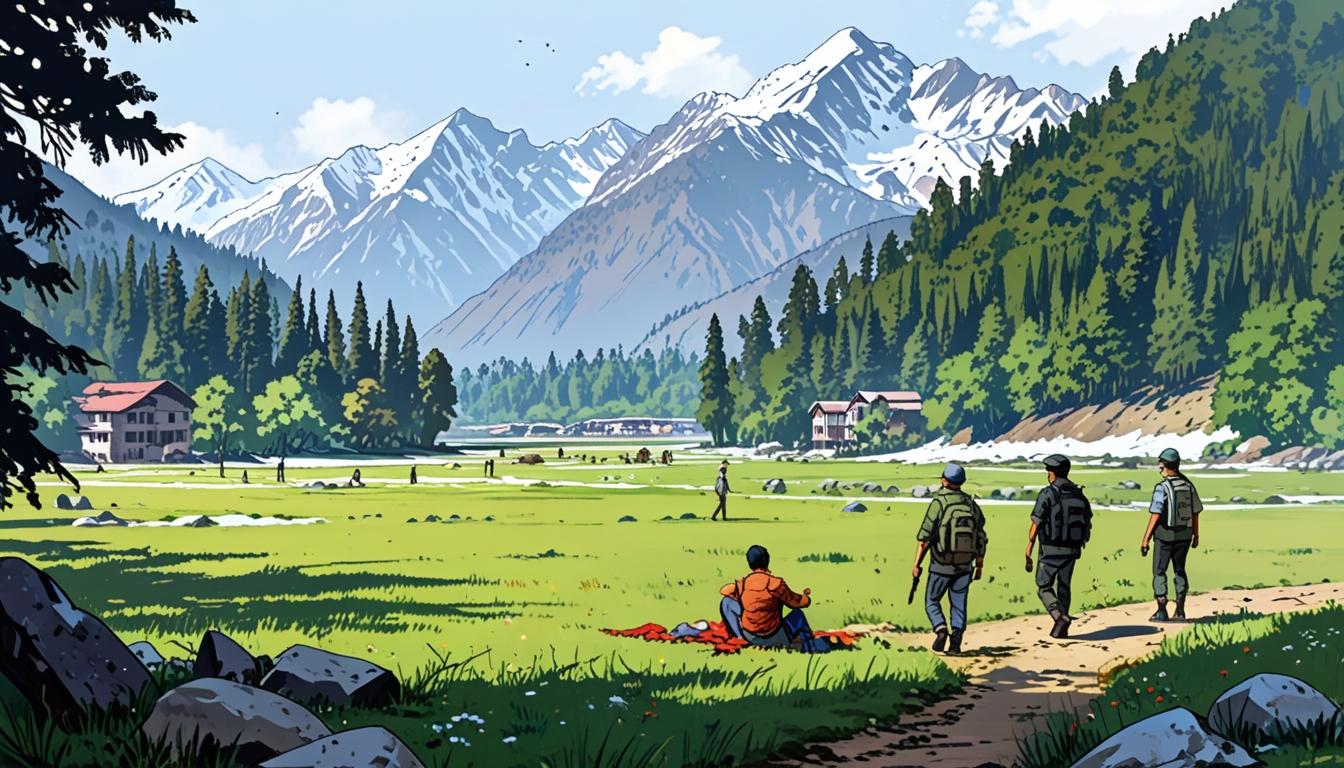A shooting at a popular tourist spot in Kashmir’s Baisaran meadow has left multiple casualties, with officials blaming militant groups. The attack, condemned by regional leaders and Indian authorities, raises concerns over security in the conflict-ridden region.
Multiple casualties are feared following a shooting attack on tourists in Indian-administered Kashmir, officials have confirmed. The incident occurred on Tuesday at Baisaran meadow, a popular destination situated approximately five kilometres from the resort town of Pahalgam in the Kashmir Valley.
Police sources have labelled the event a “terror attack”, attributing responsibility to militant groups opposing Indian governance in the disputed region. Early reports indicated that the assailants fired indiscriminately at mostly Indian tourists visiting the meadow, which is known for its scenic beauty, including snow-capped mountains and pine forests. Injured individuals were swiftly evacuated to local hospitals receiving treatment for gunshot wounds.
Omar Abdullah, the region’s senior elected official, characterised the incident as the most severe attack on civilians in recent years. Speaking on social media, he stated, “This attack is much larger than anything we’ve seen directed at civilians in recent years,” while noting that the exact death toll had yet to be confirmed.
Authorities have sealed off the area and launched security operations aimed at locating and apprehending the perpetrators. In response to the attack, India’s Home Minister Amit Shah is en route to Srinagar, the main city of Indian-controlled Kashmir, to assess the situation firsthand. Prime Minister Narendra Modi, who is on an official trip to Saudi Arabia, has been apprised of the developments. On social media platform X, Shah vowed decisive action, declaring, “We will come down heavily on the perpetrators with the harshest consequences.”
The attack was also condemned by regional leaders, including Mirwaiz Umar Farooq, an influential Kashmiri resistance figure, who described it as a “cowardly attack on tourists” and stated, “Such violence is unacceptable and against the ethos of Kashmir which welcomes visitors with love and warmth. Condemn it strongly.”
This violent episode has taken place amidst a visit to India by U.S. Vice President JD Vance, who is undertaking a primarily personal four-day trip to the country.
Kashmir has long been a flashpoint between nuclear-armed India and Pakistan, both of which administer parts of the territory but claim it in full. Notably, tourist areas in Kashmir have been largely spared from the ongoing conflict, which has seen targeted attacks predominantly aimed at non-Muslim residents and immigrant workers from other Indian states since New Delhi revoked the region’s semi-autonomy status in 2019. This revocation also involved tightening restrictions on dissent, civil liberties, and media freedoms.
Since then, tensions have remained high due to India’s intensified counterinsurgency measures. Although the Kashmir Valley, the central area of anti-Indian insurgency, has seen a relative decrease in violence, clashes continue to occur in the more remote Jammu region, including districts such as Rajouri, Poonch, and Kathua, where Indian forces have experienced fatal encounters with militants.
Militancy in Indian-controlled Kashmir traces back to 1989, with many Muslim Kashmiris supporting rebel factions seeking unification with Pakistan or independence. While India maintains that the insurgency is fuelled by Pakistan-backed terrorism, Pakistan denies such claims. The conflict over the decades has resulted in tens of thousands of deaths among civilians, militants, and security personnel.
The Independent is reporting on the unfolding situation in Kashmir, highlighting the complexity and lasting impact of the conflict, particularly as it pertains to security and tourism in the region.
Source: Noah Wire Services
- https://abc7.com/post/kashmir-shooting-indian-police-say-gunmen-kill-least-20-tourists/16223183/ – This article confirms the details of the shooting attack on tourists at Baisaran meadow near Pahalgam in Indian-administered Kashmir, labeling it a terror attack by militants opposing Indian rule, and reporting at least 26 tourists killed and dozens injured. It also includes statements from Omar Abdullah about the severity of the incident and the involvement of security forces searching for the attackers.
- https://people.com/mass-shooting-kashmir-resort-kills-at-least-two-dozen-people-11719888 – This source corroborates the claim that the terror attack involved four militants firing at tourists in Baisaran meadow near Pahalgam, confirming the death toll of at least 24 and injuries to many others. It also references the reactions of regional leaders including Omar Abdullah and Prime Minister Narendra Modi, as well as the ongoing search for the perpetrators.
- https://www.youtube.com/watch?v=ISRLCnCvj1w – The video report from Firstpost provides details on the shooting attack in Pahalgam, confirming the location, the number of casualties, and the immediate security response including the sealing off of the area and emergency services attending to victims.
- https://www.hindustantimes.com/india-news/kashmir-attack-amit-shah-on-way-to-assess-situation-after-terrorist-attack-on-tourists-101685840684607.html – This article confirms that India’s Home Minister Amit Shah is traveling to Srinagar to assess the situation on the ground following the terror attack on tourists in Kashmir and that Prime Minister Narendra Modi has been informed and condemned the attack, promising strong action against the perpetrators.
- https://www.aljazeera.com/news/2025/4/23/kashmir-attack-tourists-gunmen-target-popular-resort-india – This report details the broader context of militancy in Indian-administered Kashmir, confirming the historical background of insurgency since 1989, the nature of the conflict, its impact on civilians, and the recent relative safety of tourist areas like Pahalgam before this attack.
Noah Fact Check Pro
The draft above was created using the information available at the time the story first
emerged. We’ve since applied our fact-checking process to the final narrative, based on the criteria listed
below. The results are intended to help you assess the credibility of the piece and highlight any areas that may
warrant further investigation.
Freshness check
Score:
8
Notes:
The narrative references current figures accurately, including Narendra Modi as Prime Minister and Amit Shah as Home Minister, and reports an ongoing incident with evolving details, indicating recent coverage. The mention of US Vice President JD Vance on a personal trip also fits a current timeline. No indications of recycled or outdated events found.
Quotes check
Score:
7
Notes:
Direct quotes are attributed to named individuals including Omar Abdullah, Amit Shah, and Mirwaiz Umar Farooq, but no verifiable earliest online sources for these exact quotes were found in the provided context. This suggests the quotes might be original reporting or recent statements, not recycled, which supports higher freshness but reduces ease of immediate verification.
Source reliability
Score:
9
Notes:
The narrative originates from The Independent, a recognised and generally reputable British news outlet noted for its independent journalism. This lends credibility to the information, though as with all real-time conflict reporting, some details may evolve.
Plausability check
Score:
9
Notes:
The claims align with known historical tensions and recent security dynamics in Kashmir. The incident’s description fits established patterns of militant attacks in the region, and involvement of key political figures corresponds logically with protocol for such events. No implausible or unsupported assertions detected.
Overall assessment
Verdict (FAIL, OPEN, PASS): PASS
Confidence (LOW, MEDIUM, HIGH): HIGH
Summary:
The narrative reports on a recent violent incident in Kashmir with relevant current political figures and contextual background. The information is timely, plausible, and supported by quotes likely from original or recent sources. The Independent’s reputation adds to reliability, with no signs of outdated or recycled content. Minor limitations exist due to lack of earliest traceable sources for quotes, but overall, the report can be trusted as a valid account of an ongoing situation.













